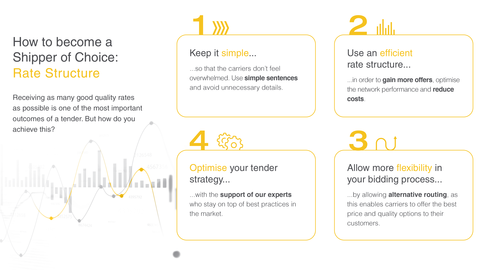Introduction
In today's ever-changing logistics and freight markets, businesses face unprecedented challenges. Supply chain disruptions, fluctuating demand, emerging technologies, new regulatory demands, and the e-commerce boom create a volatile ecosystem that deeply influences the freight market. Traditional procurement strategies are no longer enough in this complex landscape. Agile procurement isn't just advantageous, it's essential for survival and growth.
Adapting to these changes requires a shift from routine procurement to a dynamic, strategic approach. This transformation involves integrating market insights, data-driven decisions, technological innovations and strategic partnerships into a robust procurement strategy. If you're aiming to maintain efficiency, cut costs, anticipate market trends, or build a stronger, more responsive supply chain, this guide is for you. Designed to navigate the complexities of modern logistics, it provides a path to procurement agility that captures opportunities and sets a new standard for success.
Welcome to your roadmap for agile procurement in logistics—a journey from traditional methods to transformative strategies. This journey positions your procurement as a cornerstone of business success, ensuring you can thrive despite the challenges of a rapidly evolving market.
In this guide, we take you through the four essential steps needed to set up agile procurement. This will lay the foundation for a strategy that not only meets the demands of today's market but also anticipates the challenges of tomorrow.
Step1: Analyzing the market
In today's fast-evolving logistics landscape, the foundation of an agile procurement strategy begins with a thorough analysis of the market. This first crucial step empowers businesses to navigate the volatility of the freight market with informed confidence, leveraging insights to make strategic decisions that align with both current conditions and future projections.
Data-driven market observations
The shift from gut-feel decision making to a data-driven approach marks a significant evolution in how businesses forecast demand, identify trends and respond to market fluctuations. Making data-driven market observations involves a systematic analysis of data to uncover insights that inform procurement strategies. This method enables companies to anticipate changes in the market, adapt their procurement practices accordingly and maintain a competitive edge.
For an in-depth exploration of how to harness the power of data for strategic decision-making in the logistics and freight market, visit our comprehensive guide on data-driven decision making. This resource provides valuable insights into the methodologies and tools that can transform your procurement strategy from reactive to proactive, ensuring your operations are both resilient and efficient in the face of market changes.
By grounding your procurement strategy in data-driven market observations, you not only enhance your ability to react swiftly to the dynamic freight market, but also enable your business to capitalize on opportunities for growth and innovation. The insights gained from a robust analysis of market data are instrumental in developing a procurement approach that is truly agile, enabling your company to thrive in today's challenging logistics landscape.
Reacting to market developments
Agility in procurement means being able to swiftly adapt to changes in the market. This requires a dynamic strategy that can accommodate fluctuations in fuel prices, capacity constraints, and unexpected shifts in demand. A key component of this adaptive strategy is having access to real-time market intelligence that informs decision-making and strategy adjustments on the fly. By integrating these insights into your procurement strategy, you can ensure that your operations remain resilient and responsive to the ever-evolving logistics landscape.
Step 2: Deciding on a procurement strategy
Deciding on a procurement strategy is about much more than managing transactions. It's about setting a strategic direction for how goods and services are acquired in a way that aligns with your business's broader goals. This means considering a variety of approaches – including contracts, spot buying, mini-bids and strategic tenders – to find the optimal combination that meets your operational needs, financial objectives and strategic goals. The aim is to develop a procurement strategy that not only manages costs and ensures the quality and reliability of supply, but also provides the flexibility to adapt to market changes and the resilience to withstand supply chain disruptions. By carefully selecting the right mix of procurement methods, companies can achieve a balance between long-term stability and short-term agility, making procurement a powerful tool for competitive advantage in challenging markets.
Launch Better RFQs (Request for Quotes)
In the pursuit of agile procurement, the ability to launch effective RFQs is not just a procedural step, it's an essential tool that can significantly impact your ability to thrive in challenging markets. Well-crafted RFQs set the foundation for transparent, competitive bidding processes, which not only ensure cost-efficiency, but also foster innovation and collaboration with carriers. This is especially critical in volatile markets where adaptability and responsiveness are key to maintaining supply chain resilience.
The art of launching better RFQs involves clarity, precision and strategic thinking. It requires an understanding of your logistics needs, market conditions and the capabilities of potential carriers. Effective RFQs should convey your requirements succinctly yet comprehensively, enabling carriers to provide accurate and competitive bids. They also offer an opportunity to communicate your expectations regarding sustainability practices, technology integration, and innovative solutions.
For businesses looking to enhance their RFQ process, mastering the nuances of this critical procurement activity is essential. To guide you in this endeavor, we've compiled 10 Expert Tips for Launching Better RFQs. This resource is designed to elevate your RFQs, ensuring they not only meet the immediate needs of your logistics operations, but also align with long-term strategic goals. By implementing these expert insights, you can transform your RFQ process into a strategic advantage, enabling more agile, effective and competitive procurement in even the most challenging markets.
Finding the right procurement mix
Achieving agility in procurement extends beyond the tactical aspects of negotiating contracts and managing suppliers. It critically involves crafting the right procurement mix. This strategic endeavor is crucial for thriving in the challenging markets of today's freight industry. The ‘right’ mix refers to a balanced approach to selecting carriers and modes of transportation, which aligns with your company’s operational needs, financial goals and strategic objectives, including sustainability commitments and technological integration.
The procurement mix is dynamic, influenced by fluctuating market conditions, evolving business goals, and emerging opportunities for innovation. A science-based approach to shifting your procurement portfolio allows for a data-driven strategy that adapts to these changes, optimizes logistics operations, and mitigates risks associated with market volatility and supply chain disruptions.
Finding the optimal procurement mix requires a deep understanding of the market, your supply chain's specific needs, and the capabilities of your logistics partners. It involves evaluating and balancing various factors, such as cost, reliability, speed, and environmental impact, to determine the most effective combination of transportation solutions. This balanced, strategic approach ensures resilience and flexibility, enabling your business to respond swiftly and effectively to market changes and challenges.
For businesses looking to refine their procurement strategy and achieve the ideal mix, our comprehensive report on Science-Based Transportation: Shifting the Portfolio Mix offers invaluable insights. This resource delves into the principles of developing a data-driven, strategic procurement mix that supports business agility and success in the face of market uncertainties. By leveraging the insights and methodologies outlined in this report, businesses can position themselves to navigate the complexities of the freight market with confidence, ensuring sustainable competitiveness and growth.
Step 3: Selecting the right partners
Find the right partners within your network
Selecting the right partners within your network is vital for an agile procurement strategy, especially in unpredictable markets. Look for partners who align with your strategic goals, such as innovation and sustainability, and who can adapt quickly to changes. These partners should offer more than competitive rates; they should be extensions of your team, capable of providing insights, mitigating risks and adjusting to fluctuating demands.
Nurturing these partnerships is key to mutual success, creating a competitive advantage. Focus on those who demonstrate reliability, flexibility and a commitment to collaboration. By prioritizing strategic alignment and performance, you can build a resilient, dynamic procurement system that propels your business forward in challenging times.
Explore carriers outside your network
Exploring carriers outside your network can significantly enhance your logistics and procurement strategy, introducing flexibility and broadening your options in challenging markets. This approach allows you to tap into a wider pool of potential partners, each bringing unique strengths, capabilities, and pricing models that could better suit your current needs or offer innovative solutions previously unconsidered. By extending your reach beyond familiar carriers, you position your business to quickly adapt to market changes, capacity constraints, and evolving demands, ensuring that your supply chain remains resilient and competitive.





